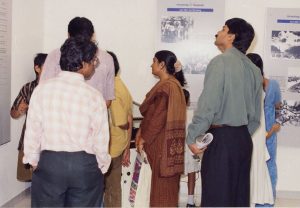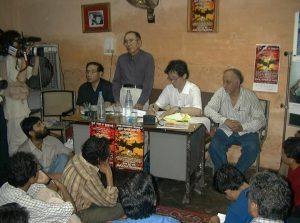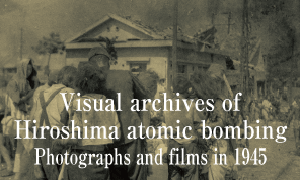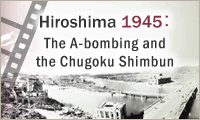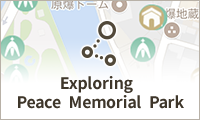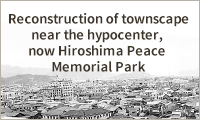Documenting Hiroshima 80 years after the A-bombing: In January 1998, A-bomb exhibition held in India
May 20, 2025
While the exhibitions were well attended, underground nuclear tests were conducted
by Michio Shimotaka, Staff Writer
On January 30, 1998, the first atomic bomb exhibition organized jointly by the cities of Hiroshima and Nagasaki was held in Mumbai, a major city in India. Items on display included a school uniform left behind by a mobilized student who had been killed in the A-bombing, photos depicting the atomic bombing, and shards of glass shattered by the blast. The horrors of the A-bombing were conveyed to the nation that had not signed the Non-Proliferation Treaty of Nuclear Weapons (NPT) and maintained a stance of pursing nuclear development.
The director of the Peace Memorial Museum testified for the first time
Minoru Hataguchi, 79, a resident of Hatsukaichi and director of the Hiroshima Peace Memorial Museum since April 1997, visited Mumbai. He spoke about his family’s experiences of the A-bombing in front of college students. He said, “This was my first testimony because I had never revealed I was an A-bomb survivor until I became director.”
At the time of the A-bombing, Mr. Hataguchi was in his mother’s womb. His mother left her home in Hatsukaichi to go into the central Hiroshima in search of his father, and there she was exposed to radiation. His father, who had been at work at the Hiroshima Railroad Bureau Management Division (now part of Minami Ward), about 1.8 kilometers from the hypocenter, was killed in the bombing. Mr. Hataguchi showed the students his father’s belt buckle and pocket watch, which had been kept in an urn beneath the grave for a long time. The watch’s short hand was burned into the clockface, pointing to eight o’clock. With these artifacts, he conveyed the horrors of the A-bombing.
He said, “When I finished speaking, I was surrounded by many students and asked for my autograph on slips of paper. I felt the power of personal belongings, testimony, and Hiroshima.” Wherever he went, members of the local press were waiting for him. The exhibition ran for about three weeks and drew 50,000 visitors. The exhibition held in New Delhi, the capital, beginning in April, also attracted many people, and its closing date was extended from May 10 to May 15.
On May 11, in the midst of the exhibition, the Indian government carried out an underground nuclear test. It was the country’s first nuclear test in 24 years. Indian Prime Minister Atal Bihari Vajpayee declared that India was already a nuclear weapon state and carried out additional nuclear test on May 13. Confronted with this reality, Mr. Hataguchi said, “I was shocked. I wondered why they ignored the A-bomb exhibitions, and how effective they were.”
Moreover, neighboring Pakistan, which had territorial disputes with India and, like India, had not signed the NPT, also conducted its first nuclear test on May 28. At a press conference, Pakistani Prime Minister Shehbaz Sharif said one of the motives was that they did not want to end up like Hiroshima or Nagasaki, and suggested the answer to nuclear weapons is nuclear weapons. Pakistan conducted another nuclear test on May 30.
An emergency delegation was dispatched
There was a storm of protest from Hiroshima. The Hiroshima Congress against A- and H-Bombs dispatched an emergency delegation, which included Yasuhiko Takeda, then 65, a resident of Aki Ward (who later passed away in 2011 at the age of 78). He had been exposed to the A-bombing as a first-year student at the former Shudo Junior High School. He lost his elder sister, Motoko, who was believed to have been mobilized and on her way to a munitions factory.
Mr. Takeda began painting scenes of the A-bombing in his 40s and, after retiring, traveled to France to protest nuclear testing. However, his eldest daughter, Yumi Enami, 62, a resident of Aki Ward, said he later developed liver cirrhosis and heart disease, and that his family opposed him visiting India and Pakistan.
Mr. Takeda was driven by the regret that his elder sister and classmates had died so young. In Hibakusha karano Tegami (Letters from Hibakusha), published in 2013, he wrote, “Why was Motoko born into this world? In her short life of 16 years and 6 months, she never traveled, never ate to her heart’s content, and never wore beautiful clothes.”
Carrying many medicines, Mr. Takeda visited India and Pakistan, where he spoke about his elder sister’s final moments and the deaths of his classmates. Ms. Enami said her father’s tenacity compelled him to sound the alarm about nuclear development.
On August 6, 1998, the ambassadors of both countries to Japan attended the Hiroshima Peace Memorial Ceremony. In the Peace Declaration, Hiroshima Mayor Takashi Hiraoka voiced strong indignation over nuclear testing. Mr. Hataguchi, who guided ambassadors and others through the Peace Memorial Museum, told them nuclear testing was deeply regrettable, but his remarks elicited no response.
As of March 2025, the Federation of American Scientists estimated that India possessed 180 nuclear warheads and Pakistan 170. Territorial disputes between the two countries also continue.
(Originally published on May 20, 2025)

